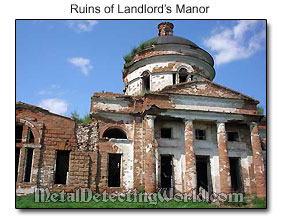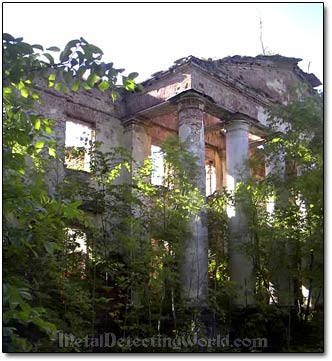Metal Detecting Research and Exploration - A Complete Guide, page 10
Map Research for Locating Treasure Hunting Sites in Europe
IMPORTANT SPECIFICS
(CONTINUED from Page 9)
In the rest of Eastern Europe, only a small class, comprised of the rich land- and serf-owners, princes and official functionaries, resided in individual mansions, just like the feudal lords in medieval times. And later, in the late 18th century, some of these manors became the starting points for new villages built around them thus forming larger estates. But sometimes the opposite occurred: the village was deliberately displaced to create the landscaped parkland around the landlord's mansion.

Serfdom was the enforced labor of peasants (serfs) tilling the fields of landowners in return for protection and the right to work on their leased fields. Serfdom involved not only the hard work in fields, but also other various activities such as forestry, mining, transportation, and crafts.
Manors with satellite villages formed the basic unit of society during this period, and the lord and his serfs were bound legally, economically, and socially. Serfs were bound to the land and formed the lowest social class of the "later feudal society."
Unlike in slavery, the serfs had their own land and property. A manorial lord could not sell his serfs, but, if he chose to dispose of a parcel of land, the serfs associated with that land went with it to serve their new lord. Further, a serf could not abandon his lands without permission, nor could he sell them. Landowners held property rights in serfs' land and labor.
For example, before the 1861 abolition of serfdom in Russia, a landowner's estate was often measured by the number of "souls" (serfs) he owned. Serfdom was a prevailing agricultural system in Eastern Europe in the early Modern Period. After the serfdom collapsed, the serfs, who found themselves emancipated, abandoned many villages they inhabited. And the manors, large and small, were finally deserted as well.
Ruins of Another Manor

Another agricultural system - the open field system, existed in much of Europe from the Middle Ages to as recently as the 20th century in some places. Under this system, each manor or village had four very large unfenced fields, farmed in strips by individual families. In Russia, the open field system, administered by the community of the peasants, predated serfdom, survived emancipation and remained as the main system of peasant land ownership until 1905.